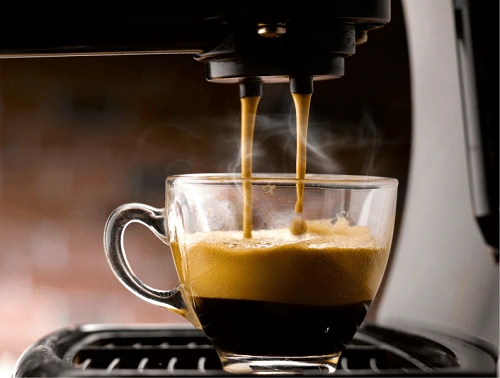Coffee, Coffee Recipes
What is Espresso Coffee and How to Make It
Espresso coffee is a concentrated and intense coffee beverage that is loved by coffee enthusiasts all around the world. It is made by forcing hot water under high pressure through finely ground coffee beans. This process extracts the flavors, oils, and aromas from the coffee, resulting in a rich and flavorful shot of espresso. In this article, we will explore the process of making espresso coffee and provide you with some tips and techniques to create the perfect cup of espresso at home.
Introduction to Espresso Coffee
Espresso is a method of brewing coffee that originated in Italy. It involves forcing pressurized hot water through finely ground coffee beans, resulting in a concentrated and flavorful shot of coffee. Unlike regular drip coffee, espresso is brewed quickly under high pressure, which extracts the essence of the coffee beans, including their oils and flavors.
Understanding the Origins of Espresso
Espresso has a rich history that dates back to the early 20th century in Italy. It was first introduced by Luigi Bezzera, who developed the concept of a fast and efficient way to make coffee. Over the years, espresso gained popularity and became an integral part of Italian coffee culture. Today, espresso is enjoyed in cafes and homes worldwide.
Different Types of Espresso Machines
There are various types of espresso machines available in the market, each with its unique features and brewing methods. The most common types include:
- Manual Espresso Machines: These machines require manual control over the brewing process, including water temperature, grind size, and extraction time. They offer full customization but require some practice to master.
- Semi-Automatic Espresso Machines: These machines automate the water delivery, but the user controls the grind size, tamp pressure, and extraction time. They provide a balance between control and convenience.
- Fully Automatic and Super-Automatic Espresso Machines: These machines automate the entire brewing process, from grinding the beans to extracting the shot. They offer convenience but limit customization options.
The Process of Making Espresso Coffee
Selecting the Coffee Beans
The first step in making espresso is selecting the right coffee beans. It is essential to choose freshly roasted beans for the best flavor. Look for beans labeled specifically for espresso or those with a dark roast profile. These beans are known for their rich and bold flavors that are ideal for espresso brewing.
Grinding the Coffee Beans
Once you have chosen your coffee beans, it’s time to grind them. For espresso, a fine grind size is necessary to ensure proper extraction. The consistency should be similar to that of powdered sugar. Invest in a good quality burr grinder to achieve a consistent grind size, as blade grinders may result in uneven particles.
Tamping the Coffee Grounds
After grinding the coffee, it’s time to tamp the grounds. Tamping is the process of evenly compressing the coffee grounds into the portafilter basket. Use a tamper and apply firm and even pressure to create a level surface. This step is crucial for ensuring proper water flow and extraction during brewing.
Brewing the Espresso
Now comes the exciting part—brewing the espresso. Attach the portafilter to your espresso machine and start the brewing process. The machine will force hot water through the coffee grounds under high pressure, typically around 9 bars. The water should pass through the coffee evenly and extract the flavors and oils, resulting in a rich and concentrated shot of espresso.
Perfecting the Espresso Shot
Achieving the perfect espresso shot requires precision and attention to detail. Factors such as brew time, extraction volume, and grind size can significantly impact the quality of the shot. It is important to experiment with these variables to find the ideal balance that suits your taste preferences.
Steaming and Frothing Milk
One of the defining characteristics of espresso-based drinks is the creamy and velvety texture of the milk. Steaming and frothing milk is a skill that enhances the overall coffee experience. Proper technique and attention to temperature are essential to create the desired micro foam for latte art and other milk-based drinks.
If you prefer milk-based espresso drinks like cappuccinos or lattes, you can steam milk to create velvety and creamy foam. Fill a stainless steel pitcher with cold milk, immerse the steam wand into the milk, and turn on the steam function. Position the wand near the surface of the milk, creating a swirling motion. Stop steaming when the milk reaches the desired temperature and consistency.
Assembling the Espresso Drink
To enjoy your espresso, you can drink it as is or use it as a base for various espresso-based drinks. Pour the brewed espresso shot into a preheated cup, and if desired, add steamed milk or foam to create your preferred espresso drink. Garnish with cocoa powder, cinnamon, or latte art if you’re feeling creative.
Factors Affecting the Taste of Espresso
The taste of espresso can be influenced by several factors. Understanding these factors will help you adjust your brewing process to achieve the desired flavor profile.
Coffee Beans
The choice of coffee beans greatly impacts the taste of espresso. Experiment with different varieties and origins to discover your preferred flavors. Consider factors such as roast level, acidity, and flavor notes when selecting your beans.
Grind Size
The grind size plays a crucial role in espresso extraction. Finer grinds increase the surface area, allowing for better extraction. However, if the grind is too fine, it can lead to over-extraction and a bitter taste. Adjust the grind size to find the sweet spot for your preferred extraction time.
Water Temperature
The ideal water temperature for brewing espresso is between 195 to 205°F (90 to 96°C). Water that is too hot can result in burnt flavors, while water that is too cold may under-extract the coffee. Make sure your espresso machine is calibrated to the correct temperature.
Brew Time
The brew time determines how long the water is in contact with the coffee grounds. Generally, a brewing time of 20 to 30 seconds is recommended for a balanced espresso shot. Adjust the grind size or the amount of coffee to control the brew time and achieve the desired extraction.
Pressure
The pressure at which the water is forced through the coffee grounds affects the extraction process. Most espresso machines maintain a pressure of around 9 bars, which helps to extract the flavors efficiently. Ensure that your machine is operating within the optimal pressure range.
Tips for Making Great Espresso Coffee
To enhance your espresso-making skills, consider the following tips:
Use Fresh Coffee Beans
Freshly roasted beans produce the best flavor in espresso. Opt for beans that have been roasted within the past two weeks. Avoid buying pre-ground coffee as it tends to lose its freshness quickly.
Grind the Beans Just Before Brewing
Grinding coffee shortly before brewing helps preserve the aroma and flavor. This way, you can experience the full potential of your coffee beans. Invest in a quality burr grinder for consistent results.
Use the Right Amount of Coffee Grounds
Using the correct coffee-to-water ratio is vital for a well-balanced shot of espresso. Start with a standard ratio of 1:2, which means 1 part coffee and 2 parts water by weight. Adjust the ratio to your taste preferences.
Preheat the Espresso Machine
Before brewing, preheat your espresso machine by running water through the group head and portafilter. This step ensures that the machine is at the optimal temperature, allowing for better extraction.
Properly Extract the Espresso Shot
During extraction, keep an eye on the coffee flowing out of the portafilter. Ideally, it should resemble a thick, honey-like stream. If it flows too fast or too slow, adjust the grind size or amount of coffee to achieve the desired extraction time.
Froth Milk to the Right Consistency
If you’re steaming milk, aim for a velvety and creamy texture. Avoid large bubbles, as they can make the milk less smooth. Practice your steaming technique to achieve consistent results.
Popular Espresso-Based Drinks
Espresso serves as the foundation for various delicious drinks. Here are a few popular espresso-based beverages you can explore:
Cappuccino
A classic cappuccino consists of equal parts espresso, steamed milk, and foam. The layers of espresso, milk, and foam create a beautiful presentation and a balanced flavor profile.
Latte
A latte is made with espresso and steamed milk, with a thin layer of foam on top. It has a milder coffee flavor compared to a cappuccino, making it a popular choice for those who enjoy a creamier and less intense coffee drink.
Americano
An Americano is a simple yet satisfying drink. It is made by diluting an espresso shot with hot water, resulting in a coffee that resembles a traditional brewed cup but with a stronger kick.
Macchiato
A macchiato is an espresso shot “stained” with a small amount of milk or foam. It provides a bolder coffee flavor with just a hint of milkiness.
Conclusion
Espresso coffee is a delightful and concentrated beverage that can be enjoyed in various forms. By understanding the process of making espresso and considering the factors that influence its taste, you can craft your perfect cup at home. Experiment with different beans, grind sizes, and brewing techniques to find the flavor profile that suits your preferences. With practice and attention to detail, you’ll be able to impress yourself and others with your espresso-making skills.
FAQs
-
Can I use any type of coffee beans for making espresso?
While you can technically use any coffee beans for making espresso, it is recommended to use beans specifically labeled for espresso or those with a dark roast profile. These beans are better suited for the intense and concentrated nature of espresso brewing.
-
How fine should I grind the coffee beans for espresso coffee?
The grind size for espresso should be fine, resembling powdered sugar. This consistency allows for proper extraction and optimal flavors. Experiment with the grind size to find the right balance for your preferred extraction time.
-
Can I make espresso without an espresso machine?
While traditional espresso requires an espresso machine, there are alternative methods to achieve a similar taste. One popular method is using a stovetop espresso maker, also known as a Moka pot. It utilizes steam pressure to extract the coffee flavors.
-
What is the difference between a cappuccino and a latte?
The main difference between a cappuccino and a latte lies in the ratio of espresso, steamed milk, and foam. A cappuccino has equal parts of each, resulting in a drier texture and a stronger coffee flavor. A latte, on the other hand, has more steamed milk and a thin layer of foam, creating a creamier and milder coffee taste.
- How can I make my espresso shots stronger?
To make your espresso shots stronger, you can adjust the coffee-to-water ratio. Increase the amount of coffee grounds relative to the water used. However, be cautious not to over-extract the coffee, as it may result in a bitter taste. Gradually experiment to find your preferred strength.

